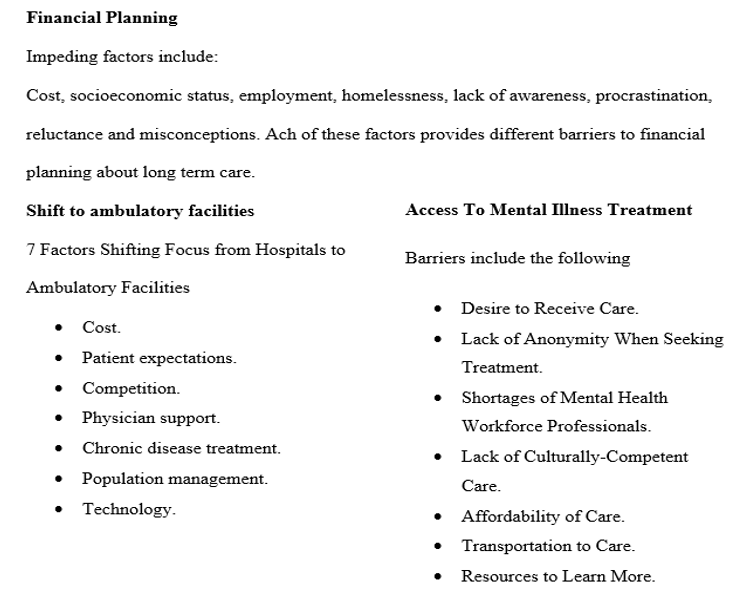The recipients of mental health services in the US represent only a small percentage of those in need of services. Discuss the factors that impede access to mental illness treatment.
Access to mental illness treatment is often impeded by several factors, including stigma, lack of resources, and systemic barriers. The stigma around mental illness can make it difficult for individuals to seek help and can create a barrier to accessing treatment. Many people fear the social and professional consequences of disclosing their mental illness, which can lead to a delay in seeking treatment (McKnight-Eily et al., 2021). Access to mental illness treatment is often impeded by several factors, including stigma, lack of resources, and systemic barriers.
Another factor that can impede access to mental illness treatment is a lack of resources. Mental health services may be unavailable or limited in certain areas, especially in rural or low-income communities (Sultz & Young, 2017). Additionally, there may be long wait times to access mental health care, which can discourage individuals from seeking treatment or exacerbate symptoms while they wait.
Systemic barriers can also make it difficult to access mental illness treatment. Insurance coverage for mental health services may be limited, and individuals may face high out-of-pocket costs for treatment. Furthermore, mental health services may be identified from other aspects of healthcare, making it challenging to coordinate care and access to comprehensive treatment (Taylor & Kuo, 2019).
Access to mental illness treatment is often impeded by several factors, including stigma, lack of resources, and systemic barriers (Sultz & Young, 2017). These barriers can create significant challenges for individuals seeking mental health care and may result in unequal access to services for vulnerable populations. To address these barriers, it is essential to increase public awareness and reduce the stigma surrounding mental illness (Taylor & Kuo, 2019).
Additional resources should be allocated to expanding mental health services in underserved communities, and insurance coverage for mental health services should be improved. Addressing systemic barriers, such as improving coordination of care and reducing discrimination, can also improve access to mental illness treatment.
Conclusion
Caring for patients is an integral part of every nurse and also creates better outcomes. As a result, patients should also be aware of the various factors that would help ensure they receive the best available care. For instance, financial planning and ensuring access to mental health care can help with the processes and increase overall patient outcome. Be that as it may, there is also a need to address barriers to accessing medical care as a means to facilitate all patients to acquire the best care
Screenshot of Notes

References
Carey, K., Morgan, J. R., Lin, M. Y., Kain, M. S., & Creevy, W. R. (2020). Patient outcomes following total joint replacement surgery: a comparison of hospitals and ambulatory surgery centers. The Journal of arthroplasty, 35(1), 7-11.
DeCook, C. A. (2019). Outpatient joint arthroplasty: transitioning to the ambulatory surgery center. The Journal of Arthroplasty, 34(7), S48-S50.